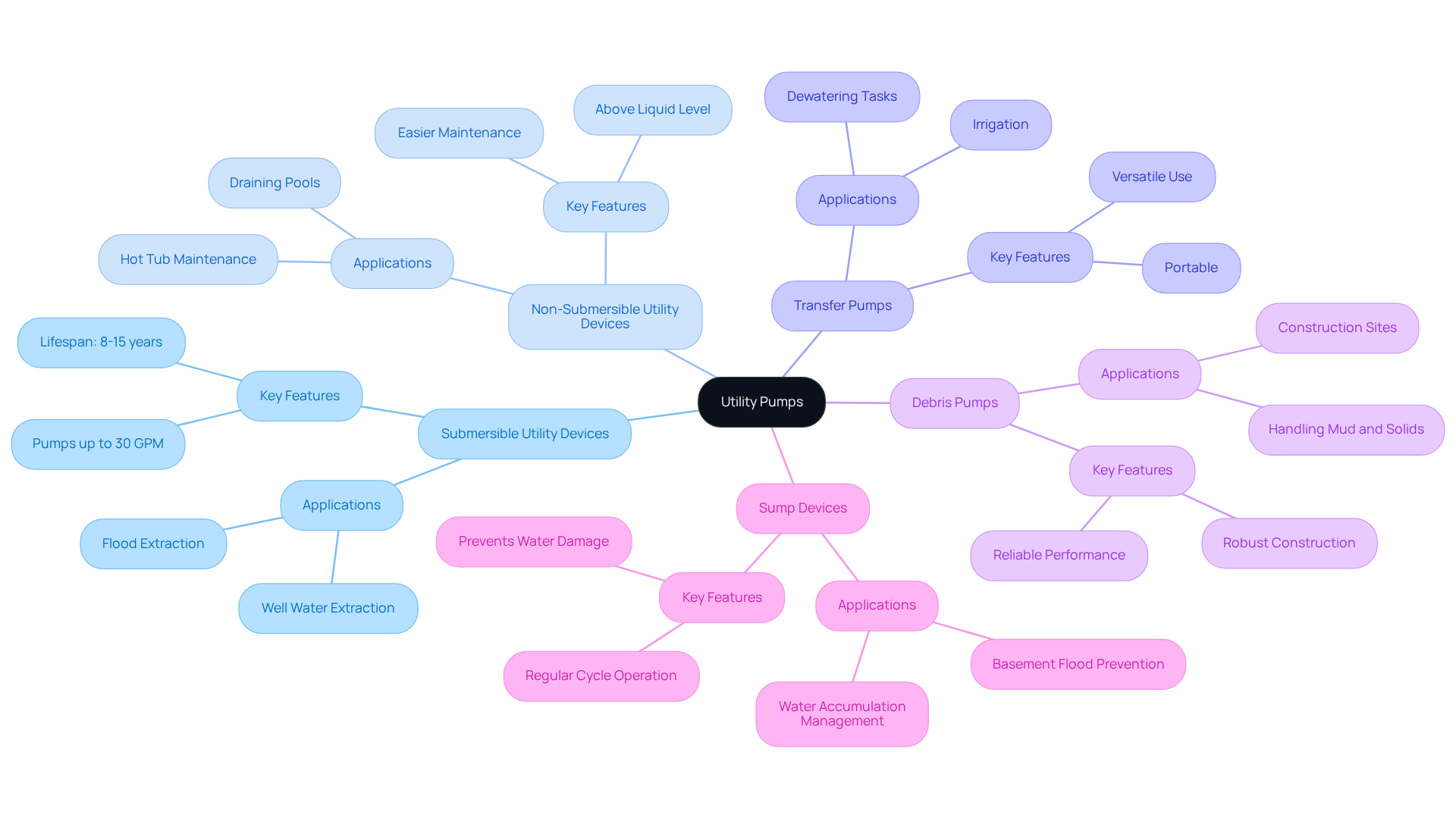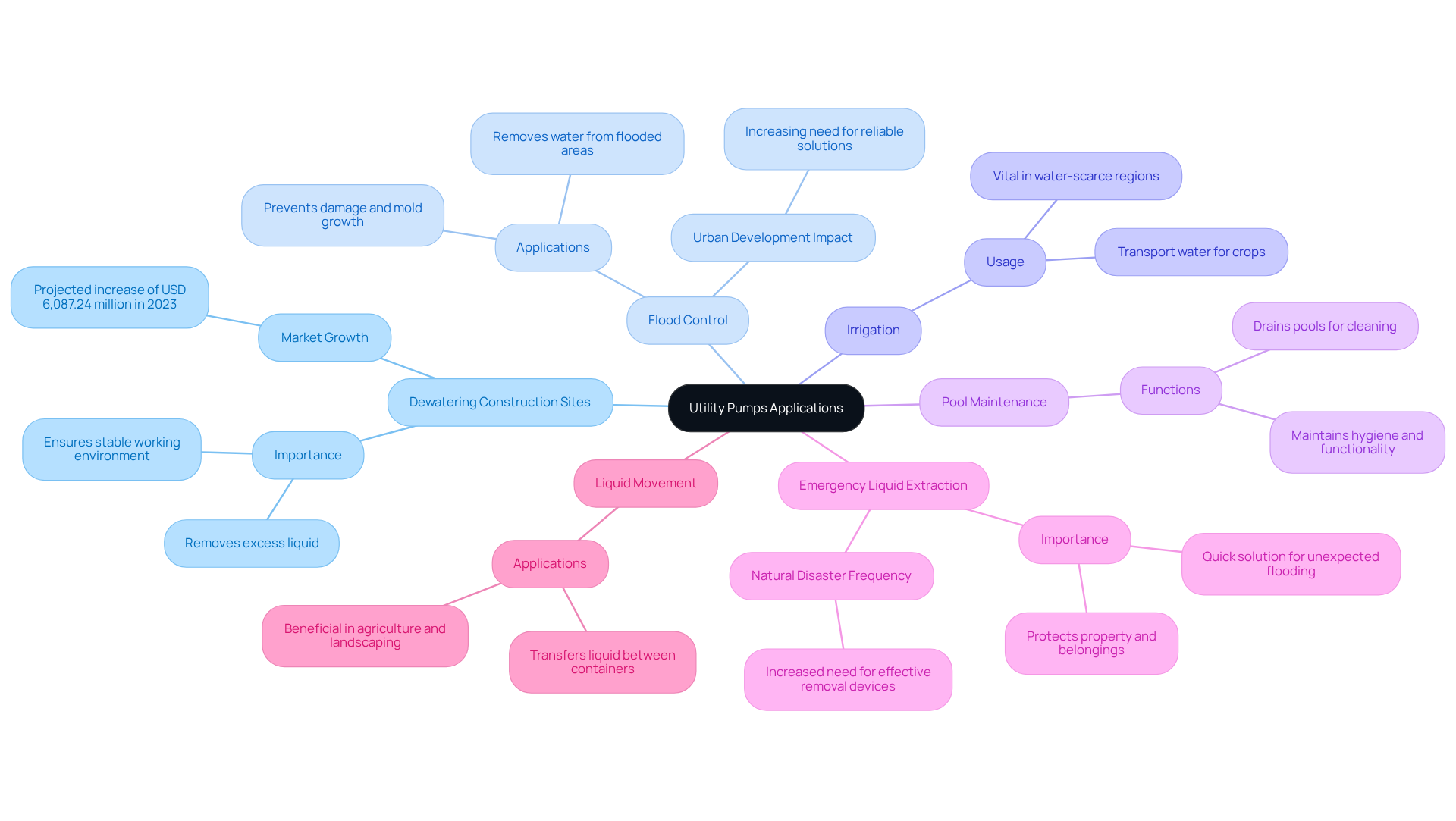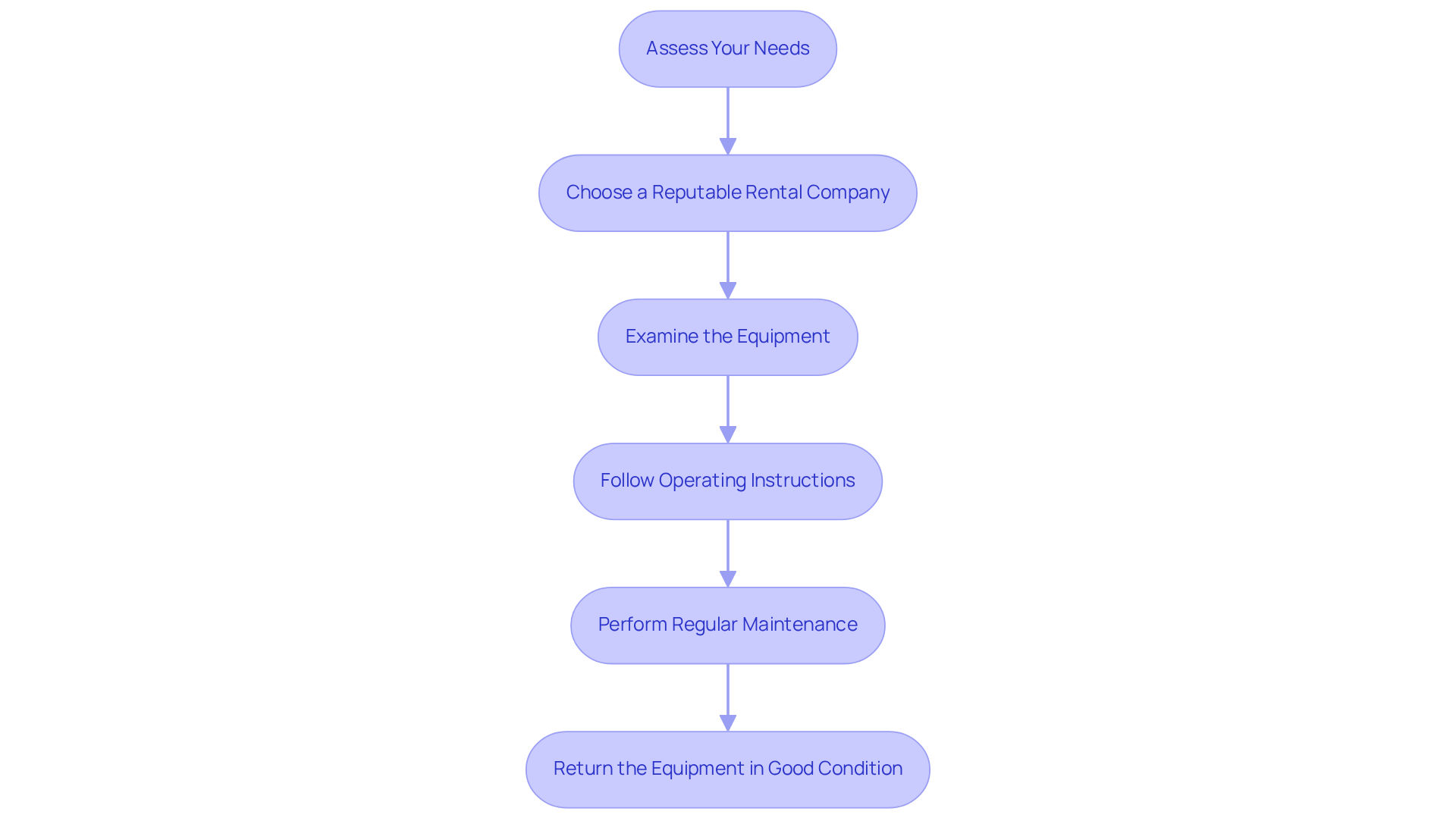Overview
Utility pump rentals are indispensable for a variety of applications, including:
- Dewatering construction sites
- Flood control
- Irrigation
- Emergency liquid extraction
Each type of utility pump serves specific tasks, and understanding these distinctions is crucial for effective use. Best practices for renting and utilizing these pumps are essential, as they ensure reliability and efficiency in both residential and commercial sectors. As demand continues to grow, it is vital to recognize the importance of selecting the right equipment to meet your needs.
Key Highlights:
- Utility pumps come in various types, each designed for specific applications, crucial for selecting the right rental.
- Submersible utility pumps are ideal for flooded areas, capable of pumping up to 30 gallons per minute and lasting 8-15 years.
- Non-submersible (pedestal) pumps operate above the liquid level, suitable for pool and hot tub draining.
- Transfer pumps are portable and used for moving liquids between containers, common in agriculture and construction.
- Debris pumps handle fluids mixed with solids, effective in construction environments.
- Sump pumps prevent basement flooding by removing liquid from sump pits.
- Utility pump rentals are vital for dewatering construction sites, flood control, irrigation, pool maintenance, emergency extraction, and liquid transfer.
- The U.S. service apparatus market for utility pumps is projected to grow significantly, indicating rising demand.
- Best practises for renting utility pumps include assessing needs, choosing reputable rental companies, inspecting equipment, following operating instructions, performing regular maintenance, and returning equipment in good condition.
Introduction
Utility pumps stand as unsung heroes in the realm of liquid management, delivering essential solutions across diverse industries, from construction sites to residential flood control. By understanding the various types of utility pump rentals and their specific applications, users can make informed decisions that significantly enhance project efficiency.
However, with a plethora of options available, how can one ascertain the best pump for their needs while ensuring optimal performance and safety? This article explores the fundamental uses of utility pumps, outlines best practices for renting and operating them, and highlights the critical factors to consider for successful liquid management.
Explore Utility Pumps: Types and Their Applications
Utility devices come in various types, each designed for specific applications. Understanding these options is crucial for selecting the right utility pump rental to meet your needs. Here are the main types:
-
Submersible Utility Devices: These devices are engineered to be immersed in liquid, making them ideal for extracting water from flooded areas such as basements or construction sites. With the capability to pump up to 30 gallons per minute, they efficiently manage large volumes of liquid. A well-maintained submersible device typically lasts between 8 to 15 years, establishing it as a dependable choice for emergency situations.
-
Non-Submersible Utility Devices: Commonly known as pedestal units, these devices are positioned above the liquid level and are suitable for transferring fluids from one area to another. They are frequently employed for draining pools or hot tubs. Their design simplifies maintenance, as they do not require submersion, making them a practical option for residential settings.
-
Transfer Pumps: These versatile pumps are utilized to transport liquid from one container to another, often in agricultural contexts for irrigation or in construction for dewatering tasks. Their portability and ease of use make them a preferred choice for temporary fluid management.
-
Debris Pumps: Specifically designed to handle fluid mixed with debris, trash pumps excel in construction environments where liquids may contain mud, leaves, or other solids. Their robust construction ensures reliable performance even in challenging conditions.
-
Sump Devices: Typically located in basements, sump devices are essential for removing accumulated liquid from a sump pit to prevent flooding. They operate on regular cycles to channel excess liquid away from homes, significantly reducing the risk of damage.
Comprehending these variations is vital for choosing the appropriate utility pump rental for your specific requirements, ensuring efficiency and effectiveness in your project. As the market evolves, the demand for both submersible and non-submersible devices continues to rise, underscoring their importance in effective liquid management solutions. Industry specialists emphasize that selecting the right type of device can significantly influence project outcomes, highlighting the necessity for thorough evaluation.

Identify Key Uses for Utility Pumps in Construction and Beyond
Utility devices, particularly utility pump rental options, play a pivotal role in efficient liquid management across various sectors. Their importance is underscored by a range of key applications:
-
Utility pump rental is indispensable for dewatering construction locations, as it effectively removes excess liquid from excavation sites, ensuring a dry and stable working environment. With the construction industry projected to grow significantly and new building project revenues expected to increase by USD 6,087.24 million in 2023, the demand for utility pump rental in this sector is increasing.
-
Flood Control: In residential areas, drainage devices swiftly remove water from flooded basements or yards, preventing damage and mold growth. Their rapid response is vital during heavy rainfall or unexpected flooding events. As urban development continues to expand, the need for reliable flood management solutions, including utility pump rental, is increasingly critical, making these devices a worthwhile investment for homeowners.
-
Irrigation: Farmers and landscapers rely on utility devices to transport water for irrigation, ensuring crops receive adequate moisture. This is particularly vital in regions facing water scarcity, where effective management is crucial for agricultural productivity.
-
Pool Maintenance: Utility devices are frequently used to drain pools for cleaning or maintenance, serving as essential tools for pool owners to maintain hygiene and functionality.
-
Emergency Liquid Extraction: In cases of unexpected flooding, a utility pump rental provides a quick solution for water removal, protecting property and belongings. The increasing frequency of natural disasters has intensified the need for effective liquid removal devices, emphasizing the significance of utility pump rental in disaster recovery scenarios.
-
Liquid Movement: Utility devices facilitate the transfer of liquid between tanks, ponds, or other containers, proving beneficial in diverse applications beyond construction, such as agriculture and landscaping.
The U.S. service apparatus market is projected to grow from USD 2.23 billion in 2025 to USD 3.04 billion by 2032, reflecting the rising demand for these indispensable tools. The diverse applications of water-moving devices highlight their crucial role in efficient water management, particularly in construction and emergency situations.

Implement Best Practices for Renting and Using Utility Pumps
To ensure a successful rental experience and optimal performance of utility pumps, it is essential to consider the following best practices:
-
Assess Your Needs: Start by evaluating the specific requirements of your project, including the type of device needed, flow rate, and head height. Understanding these factors is crucial for selecting the right equipment. For instance, the Superior Pump 91250 can move up to 1,800 gallons per hour at zero feet and has a maximum lifting height of 25 feet, making it suitable for a variety of applications.
-
Choose a Reputable Rental Company: Opt for a provider known for quality equipment and exceptional customer service, such as EZ Equipment Rental. A trustworthy company not only supplies well-maintained equipment but also offers valuable assistance throughout the rental process. As noted by industry experts, the industrial rental market for equipment is projected to reach USD 55.27 billion by 2030, underscoring the importance of selecting a reputable provider in a growing market.
-
Examine the Equipment: Before use, thoroughly check the device for any signs of damage or wear. Inspect hoses, connections, and the apparatus itself to ensure everything is functioning properly, as this can prevent operational problems later on.
-
Follow Operating Instructions: Adhere to the manufacturer's guidelines for operating the device, including proper setup, maintenance, and safety precautions. This ensures safe and efficient operation, thereby reducing the risk of equipment failure.
-
Perform Regular Maintenance: During the rental period, routinely check fluid levels, clean filters, and monitor the performance of the device. Proactive maintenance can prevent breakdowns and extend the life of the equipment. For example, utilizing an automatic float switch with the Superior Pump 91250 can enhance its functionality and prevent overheating.
-
Return the Equipment in Good Condition: After use, clean the device and return it in the same state as received. This practice not only avoids additional charges but also contributes to a smooth rental process for future customers.
By following these best practices, users can enhance their experience and ensure that their utility pump rental performs effectively throughout the rental period.

Conclusion
Understanding the various types of utility pumps and their applications is essential for effective liquid management in both residential and commercial settings. Recognizing the specific uses of submersible, non-submersible, transfer, debris, and sump pumps empowers individuals to make informed decisions when renting equipment tailored to their needs. The significance of selecting the appropriate utility pump rental cannot be overstated, as it directly impacts project efficiency and outcomes.
Throughout the article, we explored key applications of utility pumps, highlighting their critical roles in:
- Construction dewatering
- Flood control
- Irrigation
- Pool maintenance
- Emergency extraction
- Liquid transfer
The growing demand for these devices across various sectors underscores their importance, especially in light of increasing construction activities and the need for effective flood management solutions. Furthermore, adhering to best practices when renting and using utility pumps—such as assessing needs, choosing reputable rental companies, and performing regular maintenance—ensures optimal performance and longevity of the equipment.
In conclusion, the effective use of utility pumps is vital for efficient water management and disaster preparedness. As challenges related to flooding and resource management continue to evolve, embracing the benefits of utility pump rentals becomes increasingly important for homeowners, contractors, and agricultural professionals alike. By implementing the insights and best practices discussed, individuals can enhance their projects and safeguard their properties against the unpredictable nature of water.
Frequently Asked Questions
What are utility pumps and why are they important?
Utility pumps are devices designed for specific applications related to liquid management, making them crucial for tasks like water extraction, fluid transfer, and dewatering.
What are submersible utility devices?
Submersible utility devices are designed to be immersed in liquid, making them ideal for extracting water from flooded areas such as basements or construction sites. They can pump up to 30 gallons per minute and typically last between 8 to 15 years.
What are non-submersible utility devices?
Non-submersible utility devices, also known as pedestal units, are positioned above the liquid level and are used for transferring fluids. They are commonly employed for draining pools or hot tubs and are easier to maintain since they do not require submersion.
What are transfer pumps and their applications?
Transfer pumps are versatile devices used to transport liquid from one container to another, often in agricultural and construction contexts for irrigation or dewatering tasks. Their portability and ease of use make them suitable for temporary fluid management.
What are debris pumps?
Debris pumps are specifically designed to handle fluids mixed with debris, such as mud or leaves, making them ideal for construction environments. Their robust construction ensures reliable performance in challenging conditions.
What are sump devices and their purpose?
Sump devices are typically located in basements and are essential for removing accumulated liquid from a sump pit to prevent flooding. They operate regularly to channel excess liquid away from homes, reducing the risk of damage.
Why is it important to understand the different types of utility pumps?
Understanding the various types of utility pumps is vital for selecting the appropriate rental for specific needs, ensuring efficiency and effectiveness in liquid management projects.




